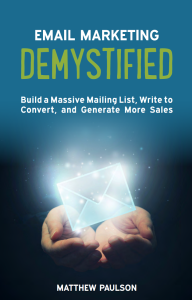Last fall, I was teaching a free class on email marketing at a local entrepreneurship center in my hometown of Sioux Falls, South Dakota. During the question and answer section of my talk, a friend noted that Email Marketing Demystified was written in 2015 and wondered if there was any out-of-date information in the book. I thought the book was still largely up-to-date and commented as such, because this book is as much about principles and strategies of marketing through email as it is about specific technologies and platforms. Regardless, I decided to give it a quick read through after the class. I didn’t find anything woefully out of date or inaccurate, but there were some sections that I thought could be expanded upon and there have been a handful of legal and technical developments since Email Marketing Demystified was first published in 2015.
 The technology, strategies and tactics that surround email marketing have not changed significantly since the first edition of the book was published. This is a testament to the stability and longevity of email as profitable marketing tool. The biggest recent development in email marketing came from a change in European law, when its General Data Protection Rules (GDPR) that went into effect in May, 2018. GDPR grants significant new rights to European consumers about how companies store and use their data, which has major implication for email marketers that have subscribers in Europe. The other significant development is that major email service providers’ spam filters have gotten much stricter. Both Gmail and Hotmail have raised the bar for letting commercial messages to get into the inbox, which makes list hygiene more important than ever. In response to these two developments, I am adding a new section on GDPR compliance to chapter eight of Email Marketing Demystified and will be adding some new ideas about improving deliverability that I have picked up during the last several years.
The technology, strategies and tactics that surround email marketing have not changed significantly since the first edition of the book was published. This is a testament to the stability and longevity of email as profitable marketing tool. The biggest recent development in email marketing came from a change in European law, when its General Data Protection Rules (GDPR) that went into effect in May, 2018. GDPR grants significant new rights to European consumers about how companies store and use their data, which has major implication for email marketers that have subscribers in Europe. The other significant development is that major email service providers’ spam filters have gotten much stricter. Both Gmail and Hotmail have raised the bar for letting commercial messages to get into the inbox, which makes list hygiene more important than ever. In response to these two developments, I am adding a new section on GDPR compliance to chapter eight of Email Marketing Demystified and will be adding some new ideas about improving deliverability that I have picked up during the last several years.
At MarketBeat, our email marketing program has grown significantly in the four year period since Email Marketing Demystified was first released. We have grown our email list from 250,000 subscribers to over 750,000 subscribers during that time. In 2018, we sent more than 400 million permission-based emails and generated $6 million in revenue from premium newsletter subscriptions, newsletter sponsorship ads and dedicated advertising emails to our mailing list. We continue to have more than 20,000 new subscribers register for our daily newsletter organically each month. We have significantly ramped up advertising spend to grow our email list. We now spend more than $100,000 each month with co-registration advertising and lead generation networks, such as Investing Media Solutions, AfterOffers, Fluent and LeadPulse.
Another major development for MarketBeat has been the advent of web push notifications (also known as browser notifications). Web push notifications are a fundamentally different technology than email, but many of the same concepts and strategies of email marketing apply. This technology is built into every major desktop web browser and is incredibly powerful because it allows you to send notifications to your website visitors that have opted-in after they have left your website. You can use your web push notification list to promote new content on your website, your products and services or even the products of your advertisers. Our business has attracted more than 300,000 web push subscribers and has generated more than $1 million in revenue from web push notifications in 2018 alone. I believe so much in web push notifications as a digital marketing tool, that I will be adding brand new chapter to the end of the book that teaches how to leverage web push notifications in your business.
In addition to the new content about web push notifications, GDPR compliance and email deliverability, I am updating each chapter of Email Marketing Demystified to include my latest tips, tricks and ideas. I am adding new recommendations for tools and services for you to use as part of your email marketing efforts. I am hoping to have the manuscript of Email Marketing Demystified’s second edition to my editor by the middle of January and launch the book sometime in March or April.
